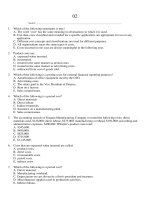Lecture Managerial accounting: Creating value in a dynamic business environment (10th edition): Chapter 13 - Ronald W. Hilton, David E. Platt
Bạn đang xem bản rút gọn của tài liệu. Xem và tải ngay bản đầy đủ của tài liệu tại đây (630.93 KB, 23 trang )
Chapter 13
Investment Centers
and Transfer Pricing
Copyright © 2014 McGraw-Hill Education. All rights reserved. No reproduction or distribution without the prior written consent of McGraw-Hill Education.
Delegation of Decision Making
(Decentralization)
Decision-Making
is pushed down.
Top
M anagem ent
M i d d le
M anagem ent
S u p e r v is o r
S u p e r v is o r
M i d d le
M anagem ent
S u p e r v is o r
S u p e r v is o r
Decentralization often occurs as organizations continue to grow.
132
Decentralization
Advantages
Allows organization
to respond more
quickly to events.
Uses specialized
knowledge and
skills of managers.
Frees top management
from day-to-day
operating activities.
133
Decentralization
Challenge
Goal Congruence:
Managers of the subunits
make decisions that achieve
top-management goals.
134
Return on Investment (ROI)
ROI =
Income
Invested Capital
ROI =
Income
Sales Revenue
Sales
Sales
Margin
Margin
Sales Revenue
×
Invested Capital
Capital
Capital
Turnover
Turnover
135
Return on Investment (ROI)
Holly Company reports the following:
Income
Sales Revenue
Invested Capital
$ 30,000
$ 500,000
$ 200,000
Let’s calculate ROI.
136
Return on Investment (ROI)
ROI =
Income
Sales Revenue
ROI =
$30,000
$500,000
Sales Revenue
×
Invested Capital
×
$500,000
$200,000
ROI = 6% × 2.5 = 15%
137
Economic Value Added
Economic value added tells us how much
shareholder wealth is being created.
138
Economic Value Added
Investment center’s after-tax operating income
– Investment charge
= Economic Value Added
(
(
Investment
center’s
total assets
Investment
center’s
current liabilities
–
) (
After-tax
Market
cost of value
debt
of debt
Market
value
of debt
)
Weighted
average
cost of capital
)
Cost of
Market
equity
value
capital
of equity
Market
value
of equity
139
Improving R0I
Decrease
Expenses
Increase
Sales
Prices
Lower
Invested
Capital
Three ways to improve ROI
1310
Residual Income
As a manager at Flower
Co., would you invest the
$100,000 if you were
evaluated using residual
income?
Would your decision be
different if you were
evaluated using ROI?
1311
Residual Income
Residual income encourages managers to
make profitable investments that would
be rejected by managers using ROI.
1312
Gross or Net Book Value
Year
1
2
3
Profits
Gross
before
Depreciation Operating
Book
Depreciation
Expense
Profits
Value
$
25,000 $
10,000 $
15,000 $ 100,000
25,000
10,000
15,000
100,000
25,000
10,000
15,000
100,000
Net
Book
Value
$ 90,000
80,000
70,000
($100,000 – $0) ÷ 10 = $10,000 per year
$100,000 – $10,000 = $90,000 net book value
1313
Gross or Net Book Value
Year
1
2
3
Net
Gross
Operating
Net Book
Book
Profits
Value
ROI
Value
ROI
$
15,000 $ 90,000 16.67% $ 100,000 15.00%
15,000
80,000 18.75% 100,000 15.00%
15,000
70,000 21.43% 100,000 15.00%
$15,000 ÷ $90,000 = 16.67%
$15,000 ÷ $100,000 = 15%
Since older assets, with lower net book
values, result in higher ROI, managers are
discouraged from investing in new assets.
1314
Measuring Investment
Center Income
Division managers should be evaluated on profit margin
they control.
Exclude these costs:
Costs traceable to the division but not controlled
by the division manager.
Common costs incurred elsewhere and allocated to
the division.
The key issue is controllability.
1315
Transfer Pricing
The transfer price affects the profit measure for both the selling
division and the buying division.
A higher transfer
price for batteries
means . . .
Battery Division
greater
profits for the
battery division.
lower profits
for the
auto division.
Auto Division
1316
Goal Congruence
The
The ideal
ideal transfer
transfer price
price allows
allows
each
each division
division manager
manager to
to make
make
decisions
decisions that
that maximize
maximize the
the
company’s
company’s profit,
profit, while
while
attempting
attempting to
to maximize
maximize his/her
his/her
own
own division’s
division’s profit.
profit.
1317
General-Transfer-Pricing Rule
Transfer
price
=
Additional outlay
cost per unit
incurred because
goods are
transferred
+
Opportunity cost
per unit to the
organization
because of
the transfer
1318
Centrally Established
Transfer Prices
As
Asaageneral
general rule,
rule,aamarket
marketprice-based
price-based
transfer
transferpricing
pricingpolicy
policycontains
containsthe
the
following
followingguidelines
guidelines......
1.
1. The
Thetransfer
transferprice
priceis
isusually
usuallyset
setat
ataa
2.
2.
discount
discountfrom
fromthe
thecost
costto
toacquire
acquirethe
theitem
item
on
onthe
theopen
openmarket.
market.
The
Theselling
sellingdivision
divisionmay
mayelect
electto
totransfer
transferor
or
to
tocontinue
continueto
tosell
sellto
tothe
theoutside.
outside.
1319
Negotiating the Transfer Price
AA system
systemwhere
wheretransfer
transferprices
pricesare
arearrived
arrivedat
atthrough
through
negotiation
negotiationbetween
betweenmanagers
managersof
ofbuying
buyingand
andselling
selling
divisions.
divisions.
Much
Much management
management
time
time is
is used
used in
in the
the
negotiation
negotiation process.
process.
Negotiated
Negotiated price
price may
may not
not
be
be in
in the
the best
best interest
interest of
of
overall
overall company
company operations.
operations.
1320
Cost-Based Transfer Prices
Some companies use the following
measures of cost to establish transfer
prices . . .
Variable cost
Full absorption cost
Beware of treating unit fixed costs as variable.
1321
Behavioral Issues:
Risk Aversion and Incentives
The design of a managerial performance
evaluation system using financial performance
measures involves a trade-off between:
Incentives for the
manager to act in
the organization’s
interests.
And
Risks imposed on the
manager because
financial performance
measures are only
partially controlled
by the manager.
1322
Goal Congruence and
Internal Control Systems
A well-designed internal control system includes a set of
procedures to prevent these major lapses in responsible
behavior:
Fraud.
Corruption.
Financial Misrepresentation.
Unauthorized Action.
1323









